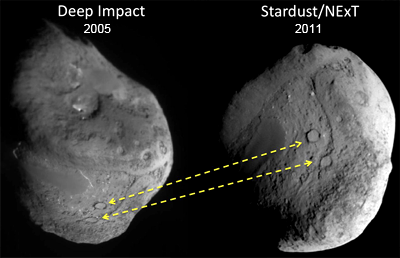Our “Date in space” was a success!

Starship “Stardust-NExT” and Comet “Tempel-1” crossed trajectories on Valentine’s day.
The happy news resulted in 72 pictures sent to Earth and plenty of data recorded by NASA’s spacecraft during the encounter.
It all happened shortly after 4:30 GMT. Stardust, travelling at a speed of 10km/sec got as close as 180 km and used its on-board navigation camera to snap a pictures of Tempel-1 every 6 seconds while receiving impacts from particles flying off the comet at 6km/sec. Sensibly, Stardust had adequate protection behind the Nextel blankets of ceramic cloth that form part of its Whipple Shield.
The exploration of Comet Tempel-1 begun with mission “Deep Impact” in 2005, when the first pictures showed most interesting features with bumps and curves on a slender 14km tall body with a diameter of 4km (JPL 2008). Further analysis will determine the changes that occurred after two successive orbits around the sun (perihelion passes).

The images taken yesterday arrived in 2 hours and were carefully processed. The results display amazing images of areas previously unseen, showing banded slopes about 2km wide and circular areas 150m in diameter (JPL 2011).
The mission was successful, fulfilling its objectives and even getting 20km closer than predicted and obtaining valuable data along the way.
Learning about comets is part of a strategy delineated by NASA in 2003:
- To learn how the solar system originated and evolved to its current state.
- To understand how life begins and determine the characteristics of the solar system that led to the origin of life.
- To catalogue and understand the potential impact hazard to Earth from space (NASA-JPL, 2011).

Pictures of the surface of Tempel-1 obtained in 2005 raise a number of questions related to the structure and history of the comet. A number of crater-like structures suggest previous collisions with smaller objects. Closer inspection also reveals smooth areas that may suggest some type of flow, possibly caused by a constant shed of particles from its surface or perhaps eruptions from the interior. Recent images from a different point of view and a new orientation of light reveal new features and allow calculation of depth and confirmation of sizes.
Using the Stardust’s navigation camera provided lower resolution images than the ones taken by the Impactor’s dedicated camera sacrificed in 2005, nevertheless, the pictures are invaluable for recording and measurement purposes.

The animation shows the strike of the Impactor deployed from Deep Impact spacecraft in 2005. Despite its small size, the collision resulted in a spectacular blow due to the high kinetic energy of the impactor (19 Gigajoules, equal to 4.8tons of TNT). This force was the result of the combination of its weight (370kg) and its velocity (10km/sec). Considering the relatively massive volume of the 14km comet, no change in trajectory was expected as a consequence of the impact (JPL 2009).
Although the latest images of the comet are not as sharp, it looks like the impactor not only flattened a 50m wide mound but also created a 150m crater on the surface of Tempel-1. This crater can be seen in the following images marked by a double yellow circle, where the outer line marks the rim and the inner circle delineates its floor. The depth of the crater is still being studied comparing photos from both visits to the comet. The location of the impact can be seen in the insert. Note its relation to the flat area, which can be seen in pictures above, close to a pair of craters believed to be 300m across.


The efficiency of re-using the spacecraft Stardust is unprecedented. The US$ 29million mission is one of the most economical at NASA, producing magnificent results and will continue "chasing comets in space."
References
¤ “Deep Impact - Mission – What did we hope to see” (2008) . NASA-University of Meryland- Jet Propulsion Laboratory [Online]. Available here. (Accessed: 14 February 2011).¤ “Impactor - Technology” (2009) NASA- Jet Propulsion Laboratory [Online]. Available here. (Accessed: 15 February 2011).
¤ “Stardust – Image Gallery” (2011) NASA [Online]. Available here. (Accessed: 16 February 2011).
¤ “Stardust - Mission and Science Objectives” (2011). NASA- Jet Propulsion Laboratory [Online]. Available here. (Accessed: 15 February 2011).
¤ “Stardust - New Territory on Tempel-1” (2011). NASA- Jet Propulsion Laboratory [Online]. Available here. (Accessed: 15 February 2011).
¤ “Stardust-NExT Mission” (2011). NASA- Jet Propulsion Laboratory [Online]. Available here. (Accessed: 14 February 2011).
No comments:
Post a Comment